Scientific name: Synsepalum dulcificum
Common names: miracle fruit, miracle berry, miraculous berry, sweet berry
Family: Sapotaceae
Origin: West Africa
Distribution: Subtropical/tropical growing environments
Abstract
Miracle fruit (Synsepalum dulcificum) is the botanical source of miraculin and an understudied tropical fruit species with potential as a natural, noncaloric sweetener. Miracle fruit originates in West Africa and requires tropical/subtropical growing conditions to thrive. The fruit pulp contains the miraculin protein. Miraculin changes the perception of sour (acidic) foods and beverages to sweet by temporarily modifying taste receptors on the tongue. Miracle fruit could play a role in reducing sugar content in some food and beverage applications and could be a viable crop for subtropical southern Florida. This report provides background information on growing miracle fruit, information on miracle fruit yield, and research on miraculin content. In summary, containerized miracle fruit plants produce up to six harvests in a single year with yields up to 3.44 kg/plant/year. Miraculin content ranged from 0.07 to 1.30 mg/g of juice. These results will be useful for selecting superior plant types and provide foundational information supporting a new industry growing miracle fruit with the natural, noncaloric sweetener miraculin. The intended audience includes commercial growers and those interested in gardening in southern Florida. The purpose of this publication is to provide accessible information about miracle fruit cultivation.
Introduction
Miracle fruit (Synsepalum dulcificum) is native to tropical West Africa but grows well in subtropical Florida. This species is valued primarily for its small, red fruit, which contain a protein called miraculin. Miraculin is a noncaloric natural sweetener. The miracle fruit plant requires special growing conditions to thrive in Florida, but the high value of the fruit ($1–$3/fruit) could incentivize expanded production. Only limited information is readily available for miracle fruit cultivation. Therefore, the purpose of this document is to provide foundational information for those interested in cultivating this novel tropical species.
Noncaloric, natural sweeteners are increasing in popularity as a means to reduce sugar content in foods and beverages. These natural sweeteners have distinct flavor characteristics, strengths, and weaknesses including metallic or other off flavors. Miraculin from miracle fruit is a protein noncaloric, natural sweetener. The protein interacts with sweet taste receptors on the tongue and increases the perception of sweetness in the presence of an acid. Therefore, the perceived sweetness of foods like lemons and strawberries is greatly increased without additional sugar. The major strength of the miraculin as a noncaloric sweetener is that its flavor profile is the closest to sugar when compared to other natural sweeteners, and it is free from metallic off flavors.
Miraculin has been well studied for its sweet-inducing properties. The overall sweetening sensory impact is ~400,000 times that of sugar, though a direct comparison is challenging. Miracle fruit and miraculin are available through online vendors in multiple formats, including live plants, fresh fruit, and freeze-dried fruit powder. Miraculin has also been reported to reduce sugar without reducing the perception of sweetness, improve insulin sensitivity, and reduce the metallic taste of foods during administration of chemotherapy treatments. These reports should be interpreted cautiously becausemany of these studies included either small sample sizes or did not measure impacts in human subjects.Therefore, miracle fruit should not be considered as a treatment for disease and should not replace consultation with competent medical professionals for legitimate health concerns.
Today, miracle fruit can be sold as a natural product, but miraculin requires additional safety assessment before it can be sold as a food or a food additive. Purified miraculin is a relatively new product, and GRAS (Generally Recognized As Safe) status is pending in the United States. Preliminary attempts to obtain GRAS status for miraculin from the FDA in the 1970s were denied due to lack of safety information (lack of “substantial history of consumption of the substances by a significant number of consumers in the United States,” US FDA 1977 Federal Register 42, 26467–26468). The rejection of GRAS status for miraculin has become the subject of conspiracy theories and a number of popular press stories pitting special-interest commodity groups against miracle fruit.
While the miraculin protein has been actively studied, the plant has only limited horticultural research. The document provides foundational information on yield and miraculin content for interested growers in southern Florida. Previously, there were no available reports on this information in the scientific literature.
Description
Plant
The miracle fruit plant is an evergreen bush that can grow several meters tall. The species is native to West African countries from Ghana to the Congo. The plant belongs to the Sapotaceae family and reportedly grows best in partial shade in well-drained soils with slightly acidic pH, but miracle fruit bushes can be found with heavy fruit set even in full sun in southern Florida. The plants are usually maintained as a compact plant to facilitate harvesting by pruning (Figure 1). Plant structure can be impacted by genetics and/or growing environment. Commercial propagation is possible through seed, though desiccation should be avoided and germination rates rapidly decline after harvest. Propagation by rooted cuttings is also possible. Grafting is not regularly practiced for miracle fruit in Florida. While formal studies have not been conducted, we anticipate that the miracle fruit species has minimal invasive potential in Florida given enclosed cultivation conditions, slow seedling growth, and rapid postharvest seed decline.
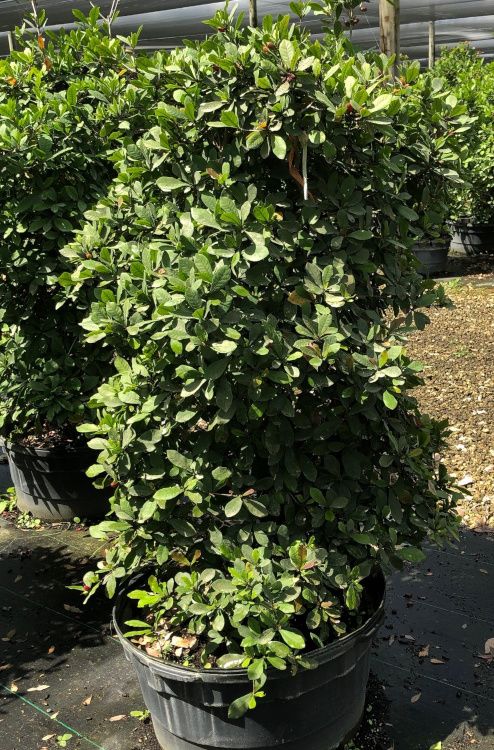
Credit: Maria Brym, UF/IFAS
Leaves
The leaves can vary in morphology from flat to wavy or curved (Figure 2). They can measure approximately 2–4 inches (5–10 cm) long by 0.5–1.5 inches (1.2–3.8 cm) wide, though there is diversity in leaf morphology. Leaf morphology can also change in response to plant health.
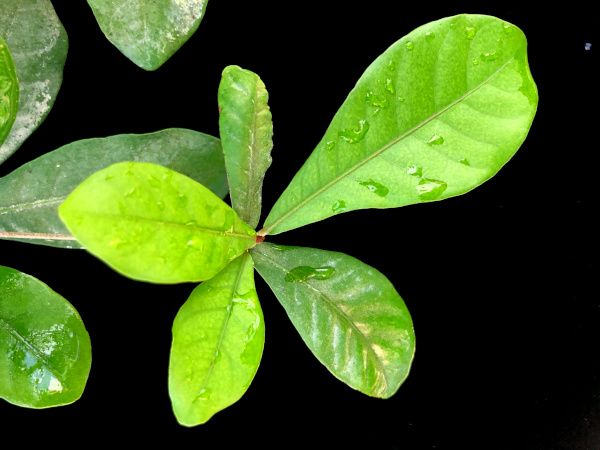
Credit: Maria Brym, UF/IFAS
Flowers and Fruit
The flowers are small, white, and hermaphroditic, and they usually form in small clusters (Figure 3). The fruit is attractive with a bright red peel, ellipsoid, and approximately 0.8 inches (2 cm) long by 0.4 inches (1 cm) wide (Figure 4). The fruit itself is not especially flavorful. A fleshy seed comprises most of the fruit volume and is surrounded by a white pulp that contains the miraculin protein. The fruit also contains vitamins and antioxidants, and it has a low sugar content. The miracle fruit berry has a short shelf life, and the miraculin protein itself is not heat stable in its native form. Miracle fruit and miraculin must therefore be processed by freeze-drying or freezing of fresh berries to preserve the taste-modifying properties. Fruit should be harvested weekly to reduce losses due to overripe fruit.

Credit: Alan H. Chambers, UF/IFAS
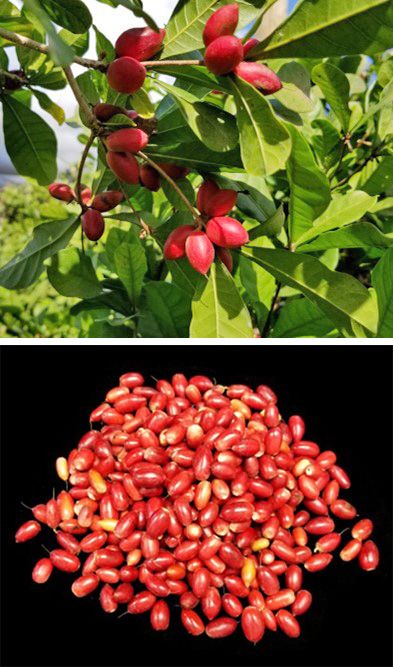
Credit: Alan H. Chambers, UF/IFAS
Maintenance
Miracle fruit plants are grown in large pots (~20 gallon) with soilless mix at 2.5 m spacing (~8 feet). Container production in southern Florida is favored in order to avoid intolerance for alkaline soils as are common in southern Florida where the plants are commercially grown. Plant fertigation has not been optimized, but regular application of a balanced 18-6-8 slow-release fertilizer will facilitate plant growth and fruiting. Further studies on plant nutrition are necessary to develop fertilizer rates. Plants should be pruned annually to facilitate harvesting. Supplemental irrigation is required during the dry season. Healthy plants can start producing fruit in their third year and reach highest yields towards their fifth year.
Pest and Diseases
Pests can include mealy bugs and mites. These can be controlled by horticultural oils or soaps according to product labels. There are no major diseases of miracle fruit in southern Florida at this time.
Miracle Fruit Yield
Total fruit yield is an important factor when considering miracle fruit production. Total miracle fruit yield was measured over one year in southern Florida under shade house (50%) conditions. Nine morphotypes were included in this study. The average total fruit yield from all trees was 2.10 kg/tree/year (fresh weight). The highest yielding tree type was ‘Imperial’ with an average of 2.76 kg/tree/year and was significantly higher than the morphotypes ‘Sangria’ (1.68 kg/tree/year) and ‘Scarlet’ (1.86 kg/tree/year) (Table 1). Some miracle fruit types only had one to three plants available for this study at the beginning of the project as indicated in Table 1. Favorable plant types could be increased in the future based on preliminary studies.
Table 1. Average annual fresh fruit yield for each plant morphotype in kg/tree/year. Only morphotypes with ten replicates were analyzed for significant differences. Averages connected by the same letter are not significantly different.
Miracle Fruit Seasonal Yield
Six peaks in miracle fruit production were identified during the year study (Figure 5). A production peak was observed approximately every two months, but the cause of plant synchronization is currently unknown. Plant health and nutritional status can impact both the number of harvests and the total yield.
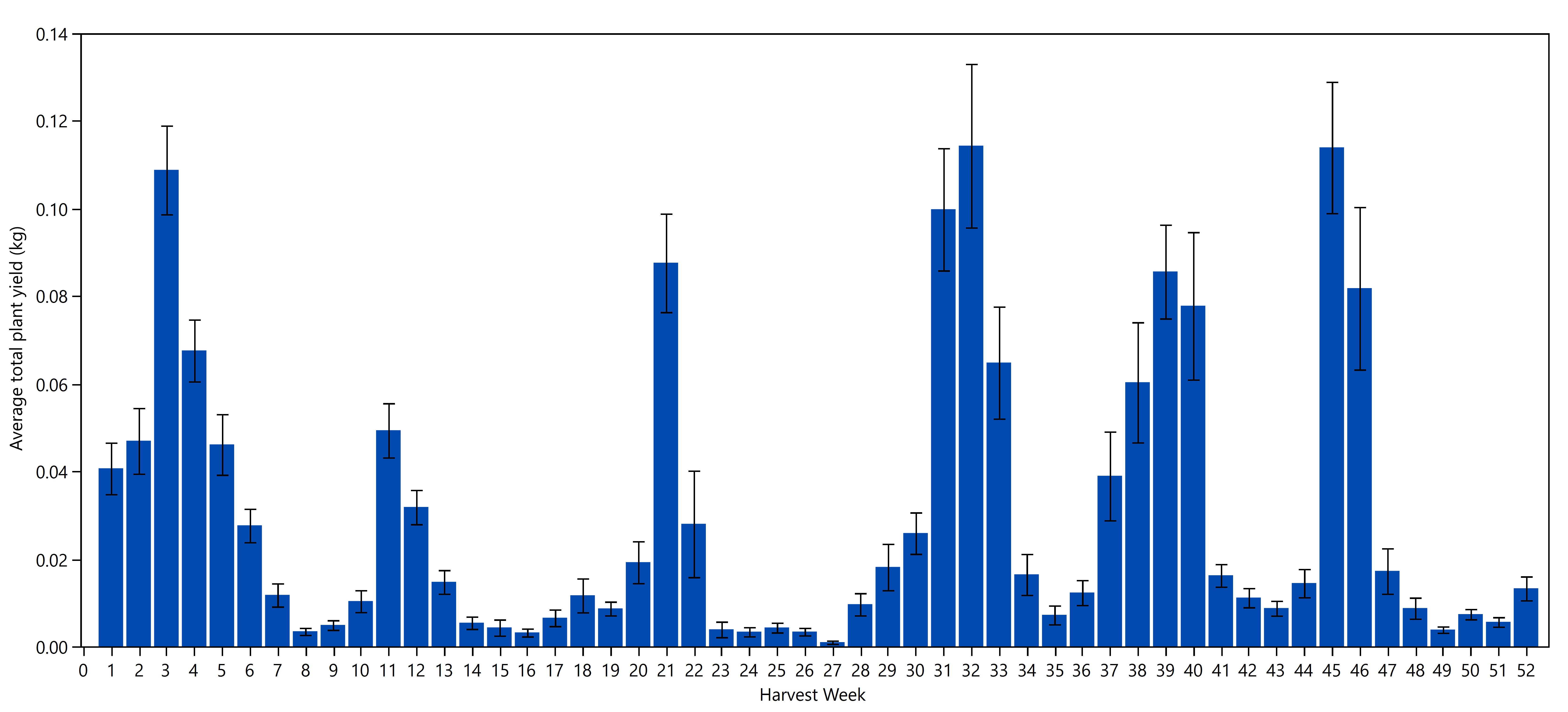
Miracle Fruit Total Yield by Individual Plant
There can be significant differences among trees within the different types. This can be the result of genetics or the growing environment. This also means that distinct tree types could be placed into incorrect groups in the absence of DNA tests. Therefore, individual trees were analyzed for yield performance over one year to investigate if superior types were present (Figure 6). Total yield ranged from 0.06 (Tree 122) to 3.44 (Tree 113) kg/tree/year. Yield variability within each morphotype was observed, and some of the highest-yielding plants within morphotypes produced twice the yield of the lowest-yielding trees. Multiple-year trials are pending wider commercial adoption, grower interest, and funding.
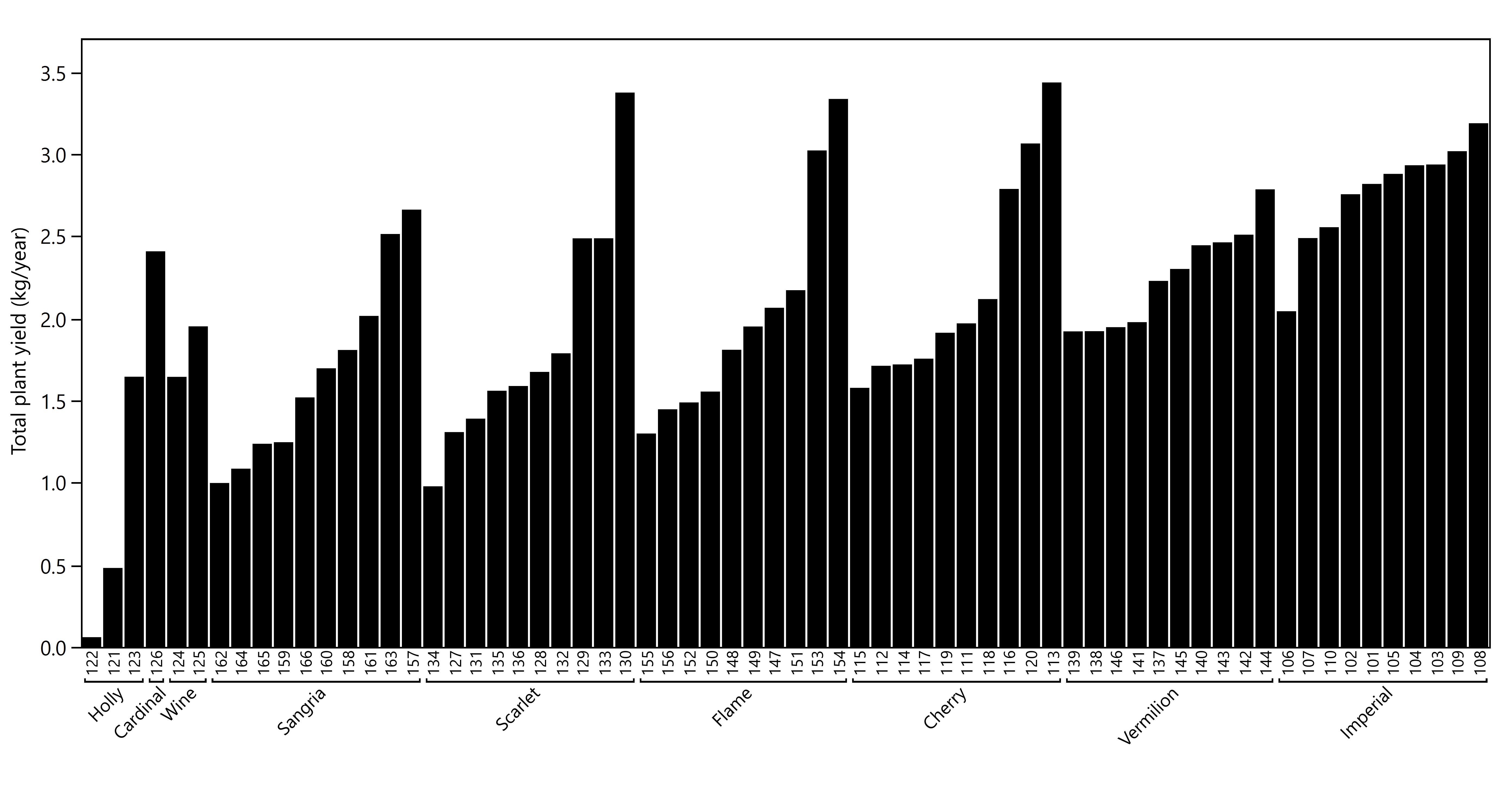
Average Fruit Weight
Larger fruit could be caused by increased pulp content that and could impact total miraculin yield. Fruit were counted for each individual tree and harvest over 25 weeks to obtain average fruit weights. The average fruit weight for all samples was 1.39 g and ranged from 0.13 to 2.96 grams per fruit. ‘Imperial’, ‘Cherry’, ‘Scarlet’, and ‘Vermilion’ all had significantly higher average fruit weight than ‘Flame’, ‘Holly’, ‘Sangria’, ‘Wine’, and ‘Cardinal’.
Table 2. Average fruit weight, length, width, and pulp thickness for each morphotype in this study. Average fruit weight data was recorded for each weekly harvest over 25 weeks. Fruit dimensions represent averages from twenty representative fruit from each tree for the nine morphotypes. Results with the same letter are not significantly different.
Fruit Dimensions and Pulp Thickness
Increased fruit pulp could lead to more miraculin. Whole fruit length and width were measured to detect differences among the plant morphotypes (Table 2). Sixty-two trees had fruit available for fruit dimension measurements at the time of sampling. The average fruit length was 1.99 cm and ranged from 1.63 to 2.34 cm. The average fruit width was 1.18 cm and ranged from 1.04 to 1.34 cm. Fruit length and width were not highly correlated (R2=0.10). ‘Holly’ and ‘Cardinal’ has significantly higher average fruit length compared to ‘Flame’ and ‘Scarlet’. ‘Cherry’, ‘Holly’, and ‘Cardinal’ had significantly higher width than ‘Flame’, ‘Sangria’, ‘Vermilion’, and ‘Wine’.
Increased pulp thickness could result in higher total miraculin content. Fruit were sliced in half and imaged to measure pulp thickness for the morphotypes in this study (Table 2). Average pulp thickness along the horizonal axis (transverse) was 0.25 cm and ranged from 0.18 to 0.31 cm. Average pulp thickness along the length axis (longitudinal) was 0.28 and ranged from 0.21 to 0.33 cm. Width and length pulp thickness were moderately correlated at R2=0.75. ‘Imperial’, ‘Cherry’, ‘Flame’, and ‘Holly’ had significantly higher pulp thickness along both width and length axes compared to ‘Cardinal’.
Miraculin Content
Measuring the amount of a specific protein can be achieved using a technique called High Performance Liquid Chromatography (HPLC). HPLC can detect individual compounds in a complex liquid mixture. HPLC was used to measure the amount of miraculin in juiced miracle fruit.The fruit were juiced by slicing the fruit in half and blending the fruit using a whisk attachment for a hand blender and then filtering the juice through cheesecloth. The highest miraculin content was 1.31 mg miraculin/gram of juice for tree 151, a ‘Flame’ type (Figure 7). The average miraculin content was 0.29 mg/gram of fruit juice, and the lowest included samples with undetectable levels of miraculin.This average value is roughly 30 times the amount of miraculin needed to obtain the full sensory miraculin effect, though this is just an approximation. Future work could include total miraculin production per cultivar per year, though this would additionally require scaling up sample preparation using commercial equipment.
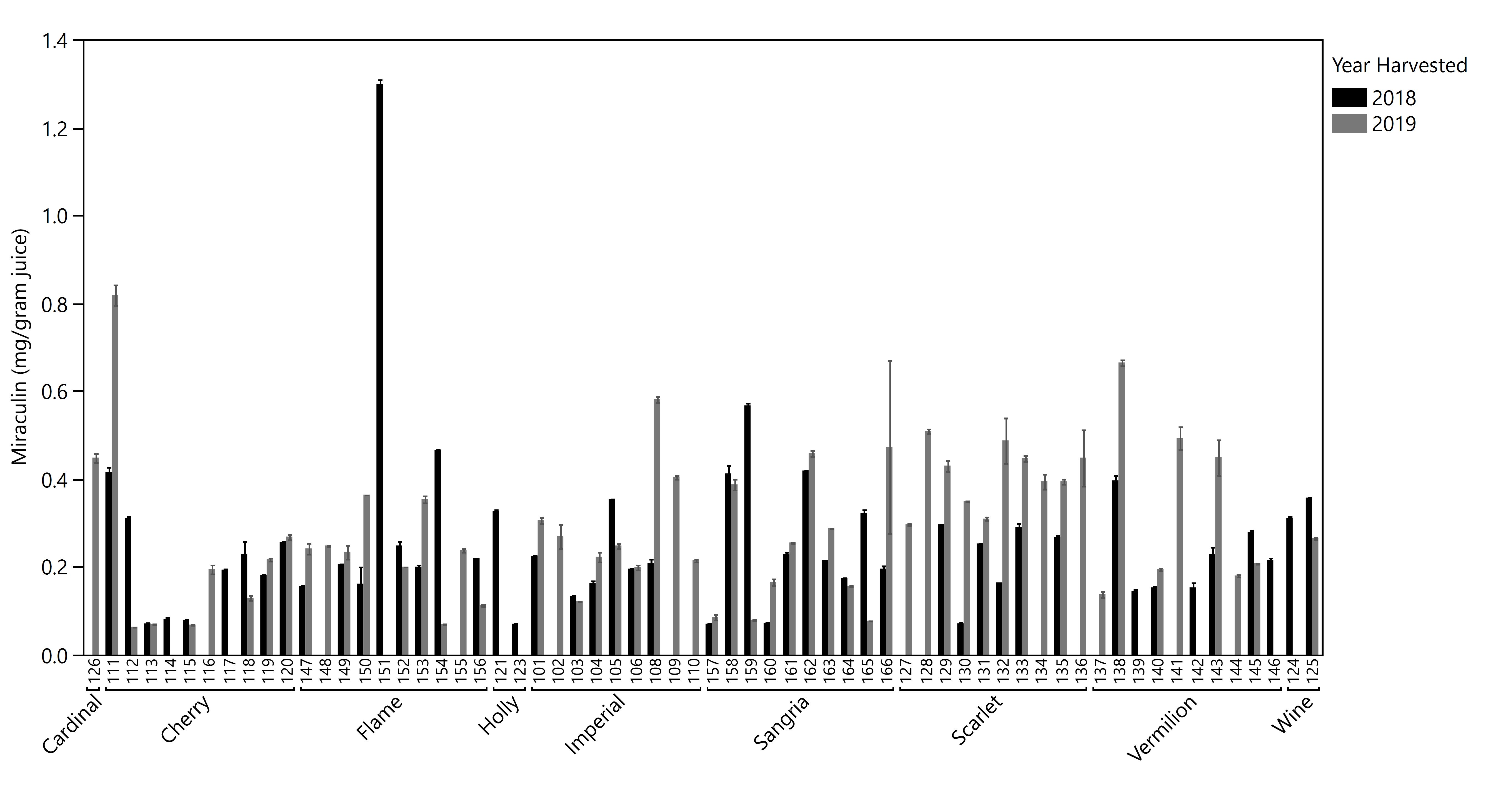
There were 29 trees that had fruit available for miraculin quantification in two consecutive years. The average miraculin content for these trees was significantly higher in 2019 than in 2018 (0.313 and 0.252 mg/g juice, respectively), and they were therefore analyzed by year (Figure 7). Five trees, including 111 (‘Cherry’), 133 (‘Scarlet’), 135 (‘Scarlet’), 138 (‘Vermilion’), and 162 (‘Sangria’), were among the top ten trees for miraculin for both 2018 and 2019. Conversely, 104 (‘Imperial’), 119 (‘Cherry’), 140 (‘Vermilion’), 157 (‘Sangria’), and 164 (‘Sangria’) were among the ten trees with the lowest miraculin for both years. Future work could include the propagation of individual, superior trees to investigate if these trends are consistent year after year.
Conclusions
Miracle fruit has great potential for expanded production in tropical growing regions. As for many other specialty crops, there is only limited information and research available to support expanded cultivation of miracle fruit. This document details some recent findings to guide those interested in cultivating miracle fruit. Overall, there are significant differences in yield and miraculin content among the plants reported here, and this should be considered when establishing a new planting. While there is still much to learn about optimizing miracle fruit cultivation, there is great potential for this crop given the limited information currently available. Miracle fruit will certainly benefit from additional research as the demand for natural, noncaloric sweeteners increases over the coming years. Morphotypes ‘Cardinal’ and ‘Imperial’ were among the types with the highest average number of fruit per tree per season (~1,800 to 1,900) and could be the most profitable for growers selling individual fruit.
Acknowledgments
The authors gratefully acknowledge Miracle Fruit Farm, Homestead, FL for donating miracle fruit seeds for this project. They also acknowledge Christian Collazo for his assistance with seed preparation.
Additional Reading
Demesyeux, Lynhe, Maria Brym, Dayana Valdes, Christian Collazo, and Alan H. Chambers. “Yield and Miraculin Content of Nine Miracle Fruit (Synsepalum dulcificum) Morphotypes.” Euphytica 216:181. https://doi.org/10.1007/s10681-020-02710-x
US FDA. 1977. “Miracle Fruit Berries, Concentrates, and Extracts; Denial of GRAS Affirmation and Determination of Food Additive Status [Docket No. 76G-0412].” Fed. Regist. 42, 26467–26468.